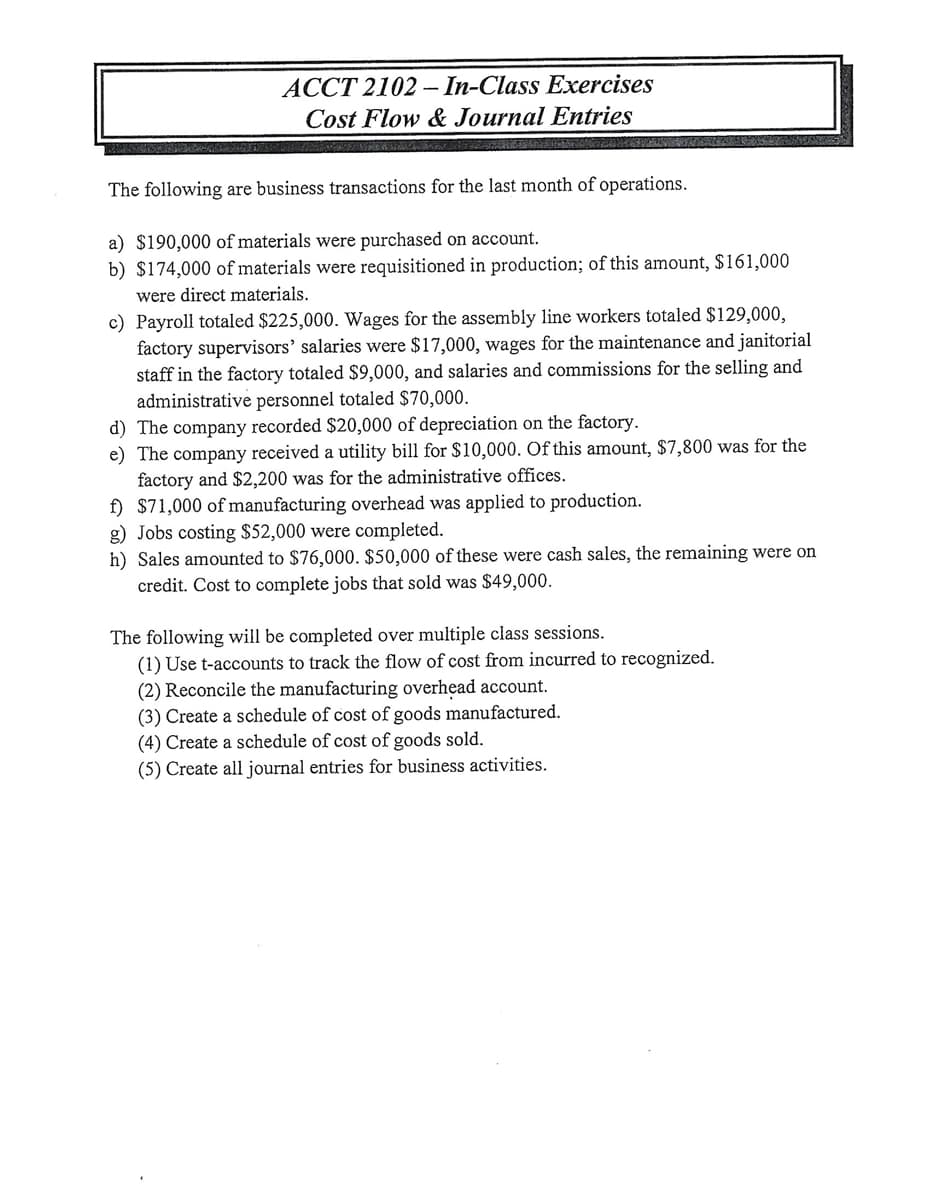The following are business transactions for the last month of operations. a) $190,000 of materials were purchased on account. b) $174,000 of materials were requisitioned in production; of this amount, $161,000 were direct materials. c) Payroll totaled $225,000. Wages for the assembly line workers totaled $129,000, factory supervisors' salaries were $17,000, wages for the maintenance and janitorial staff in the factory totaled $9,000, and salaries and commissions for the selling and administrative personnel totaled $70,000. d) The company recorded $20,000 of depreciation on the factory. e) The company received a utility bill for $10,000. Of this amount, $7,800 was for the factory and $2,200 was for the administrative offices. f) $71,000 of manufacturing overhead was applied to production. g) Jobs costing $52,000 were completed. h) Sales amounted to $76,000. $50,000 of these were cash sales, the remaining were on credit. Cost to complete jobs that sold was $49,000. The following will be completed over multiple class sessions. (1) Use t-accounts to track the flow of cost from incurred to recognized. (2) Reconcile the manufacturing overhead account. (3) Create a schedule of cost of goods manufactured. (4) Create a schedule of cost of goods sold. (5) Create all journal entries for business activities.
The following are business transactions for the last month of operations. a) $190,000 of materials were purchased on account. b) $174,000 of materials were requisitioned in production; of this amount, $161,000 were direct materials. c) Payroll totaled $225,000. Wages for the assembly line workers totaled $129,000, factory supervisors' salaries were $17,000, wages for the maintenance and janitorial staff in the factory totaled $9,000, and salaries and commissions for the selling and administrative personnel totaled $70,000. d) The company recorded $20,000 of depreciation on the factory. e) The company received a utility bill for $10,000. Of this amount, $7,800 was for the factory and $2,200 was for the administrative offices. f) $71,000 of manufacturing overhead was applied to production. g) Jobs costing $52,000 were completed. h) Sales amounted to $76,000. $50,000 of these were cash sales, the remaining were on credit. Cost to complete jobs that sold was $49,000. The following will be completed over multiple class sessions. (1) Use t-accounts to track the flow of cost from incurred to recognized. (2) Reconcile the manufacturing overhead account. (3) Create a schedule of cost of goods manufactured. (4) Create a schedule of cost of goods sold. (5) Create all journal entries for business activities.
Principles of Cost Accounting
17th Edition
ISBN:9781305087408
Author:Edward J. Vanderbeck, Maria R. Mitchell
Publisher:Edward J. Vanderbeck, Maria R. Mitchell
Chapter2: Accounting For Materials
Section: Chapter Questions
Problem 5E: Recording materials transactions Prepare a journal entry to record each of the following materials...
Related questions
Question

Transcribed Image Text:ACCT 2102-In-Class Exercises
Cost Flow & Journal Entries
The following are business transactions for the last month of operations.
a) $190,000 of materials were purchased on account.
b) $174,000 of materials were requisitioned in production; of this amount, $161,000
were direct materials.
c) Payroll totaled $225,000. Wages for the assembly line workers totaled $129,000,
factory supervisors' salaries were $17,000, wages for the maintenance and janitorial
staff in the factory totaled $9,000, and salaries and commissions for the selling and
administrative personnel totaled $70,000.
d) The company recorded $20,000 of depreciation on the factory.
e) The company received a utility bill for $10,000. Of this amount, $7,800 was for the
factory and $2,200 was for the administrative offices.
f) $71,000 of manufacturing overhead was applied to production.
g) Jobs costing $52,000 were completed.
h) Sales amounted to $76,000. $50,000 of these were cash sales, the remaining were on
credit. Cost to complete jobs that sold was $49,000.
The following will be completed over multiple class sessions.
(1) Use t-accounts to track the flow of cost from incurred to recognized.
(2) Reconcile the manufacturing overhead account.
(3) Create a schedule of cost of goods manufactured.
(4) Create a schedule of cost of goods sold.
(5) Create all journal entries for business activities.
Expert Solution
This question has been solved!
Explore an expertly crafted, step-by-step solution for a thorough understanding of key concepts.
This is a popular solution!
Trending now
This is a popular solution!
Step by step
Solved in 6 steps with 7 images

Knowledge Booster
Learn more about
Need a deep-dive on the concept behind this application? Look no further. Learn more about this topic, accounting and related others by exploring similar questions and additional content below.Recommended textbooks for you

Principles of Cost Accounting
Accounting
ISBN:
9781305087408
Author:
Edward J. Vanderbeck, Maria R. Mitchell
Publisher:
Cengage Learning

Managerial Accounting
Accounting
ISBN:
9781337912020
Author:
Carl Warren, Ph.d. Cma William B. Tayler
Publisher:
South-Western College Pub

Cornerstones of Cost Management (Cornerstones Ser…
Accounting
ISBN:
9781305970663
Author:
Don R. Hansen, Maryanne M. Mowen
Publisher:
Cengage Learning

Principles of Cost Accounting
Accounting
ISBN:
9781305087408
Author:
Edward J. Vanderbeck, Maria R. Mitchell
Publisher:
Cengage Learning

Managerial Accounting
Accounting
ISBN:
9781337912020
Author:
Carl Warren, Ph.d. Cma William B. Tayler
Publisher:
South-Western College Pub

Cornerstones of Cost Management (Cornerstones Ser…
Accounting
ISBN:
9781305970663
Author:
Don R. Hansen, Maryanne M. Mowen
Publisher:
Cengage Learning

Managerial Accounting: The Cornerstone of Busines…
Accounting
ISBN:
9781337115773
Author:
Maryanne M. Mowen, Don R. Hansen, Dan L. Heitger
Publisher:
Cengage Learning

College Accounting, Chapters 1-27
Accounting
ISBN:
9781337794756
Author:
HEINTZ, James A.
Publisher:
Cengage Learning,

Principles of Accounting Volume 2
Accounting
ISBN:
9781947172609
Author:
OpenStax
Publisher:
OpenStax College